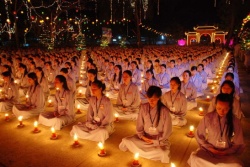Three refuges
Taking refuge and possessing confidence in the
Taking refuge and possessing confidence in the Buddha's Awakening, in his Teaching and in the Sangha of enlightened disciples.
At some point in our learning and practice, we will likely wish to formally commit ourselves to the Buddhist path. To do this, we take refuge in the Three Jewels of the Buddha, Dharma, and Sangha. When we do so, we are not taking refuge in someone or something outside of ourselves. The Three Jewels represent virtues that are already within each of us; thus, taking refuge in the Three Jewels is to return to the sanctuary of our own true nature, to our own innate virtues and goodness.
When we take refuge in the Buddha, we are leaving blind faith and delusion behind us as we seek to awaken and uncover the true nature within us. The Buddha was an ordinary man who attained supreme enlightenment. He wisely understood the causes of pain and unhappiness, and compassionately showed us the path he had taken so that we too might break free from suffering.
Each of us has the same true nature as the Buddha. Each of us has the potential to look within and return to that true nature. The choice to do so is entirely up to us. To take refuge in the Buddha is to make a commitment to ourselves, to our inner Buddha-nature. That commitment says that we will do everything we can to awaken and to uncover the inner goodness, compassion, and wisdom that lie deep within us.
When we take refuge in the Dharma, we are returning from incorrect views to right views and correct understanding. Our present lack of awareness and proper comprehension have obstructed us from seeing the reality of life and caused us to look at everything in a distorted way, as if we were looking at things through a tiny blurred window. When our minds become pure and our misconceptions are replaced with right understanding, we will give rise to wisdom and be able to see everything clearly. Since sutras are records of the Buddha’s teachings and describe the truth of the universe, we can use the sutras as guidelines. If our thinking coincides with what is in the sutras, then our comprehension is correct.
Only when we clearly see the whole can our viewpoints and understanding be wise. The teachings of all Buddhas flow from their true natures. They teach us how to let go of benefiting solely ourselves, to attain purity of mind, to see life clearly, and to become enlightened. Upon hearing the teachings, we should be respectful and remind ourselves to cultivate right understanding and proper views.
When we take refuge in the Sangha, the community of those who practice the teachings, we are returning from pollution and dissension to purity of mind and harmony. As we associate with those who practice understanding and loving-kindness, and who feel and practice as we do, we will begin to learn from them.
Currently, our minds, spirits, and bodies are impure. The Buddha taught us that everything is a reflection of the mind. Everything therefore arises from the mind; in other words, from our thoughts and feelings. When our minds begin to clear, allowing us to see and understand why things happen, we will stop judging others and cease wanting them to meet our expectations. We will gradually find contentment with what we have. As we interact with others and handle situations more harmoniously, we will begin to be content with who we are.
Sincerely taking refuge in the Three Jewels will help us restore the perfect wisdom and virtues of our true nature so that we can attain clarity, freedom, and genuine happiness.
It is best to take the Three Refuges with a monastic who you think will be a good mentor to you: someone whom you can learn from, seek assistance from, and be associated with. If, however, you have no access to a monk or a nun, you can take the refuges yourself as an alternative. When you take the refuges with a monk or nun, remember that he or she is simply passing on the vow to you and serving as a witness. You are not taking refuge in that individual.

